2013.5 Peugeot 308 CC wheel
[x] Cancel search: wheelPage 124 of 268
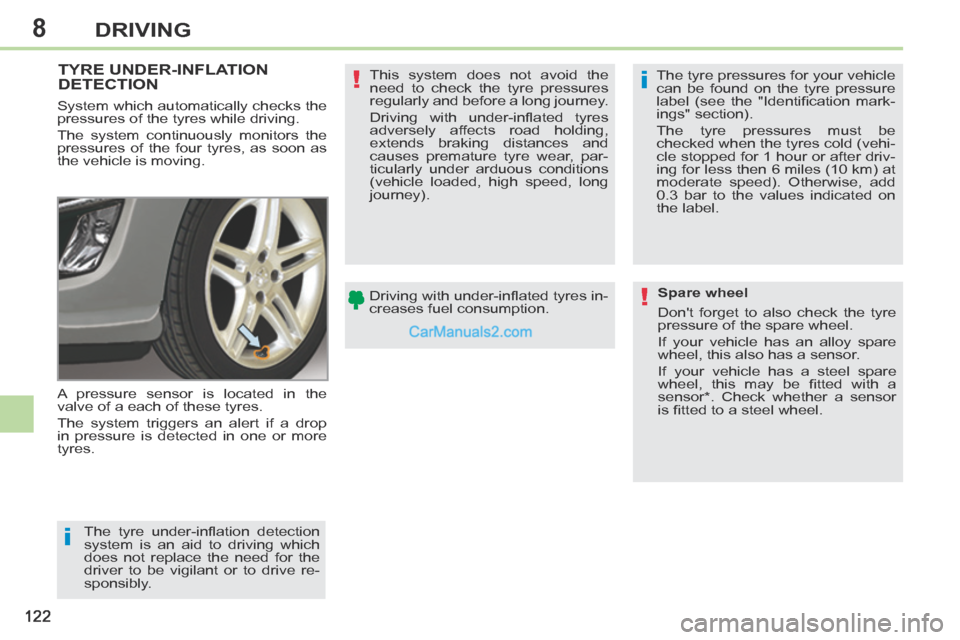
8
i
i
!
!
122
DRIVING
TYRE UNDER-INFLATION DETECTION
A pressure sensor is located in the
valve of a each of these tyres.
The system triggers an alert if a drop
in pressure is detected in one or more
tyres. This system does not avoid the
need to check the tyre pressures
regularly and before a long journey.
Driving with under-infl ated tyres
adversely affects road holding,
extends braking distances and
causes premature tyre wear, par-
ticularly under arduous conditions
(vehicle loaded, high speed, long
journey).
System which automatically checks the
pressures of the tyres while driving.
The system continuously monitors the
pressures of the four tyres, as soon as
the vehicle is moving.
The tyre under-infl ation detection
system is an aid to driving which
does not replace the need for the
driver to be vigilant or to drive re-
sponsibly. Driving with under-infl ated tyres in-
creases fuel consumption.
The tyre pressures for your vehicle
can be found on the tyre pressure
label (see the "Identifi cation mark-
ings" section).
The tyre pressures must be
checked when the tyres cold (vehi-
cle stopped for 1 hour or after driv-
ing for less then 6 miles (10 km) at
moderate speed). Otherwise, add
0.3 bar to the values indicated on
the label.
Spare wheel
Don't forget to also check the tyre
pressure of the spare wheel.
If your vehicle has an alloy spare
wheel, this also has a sensor.
If your vehicle has a steel spare
wheel, this may be fi tted with a
sensor * . Check whether a sensor
is fi tted to a steel wheel.
Page 125 of 268
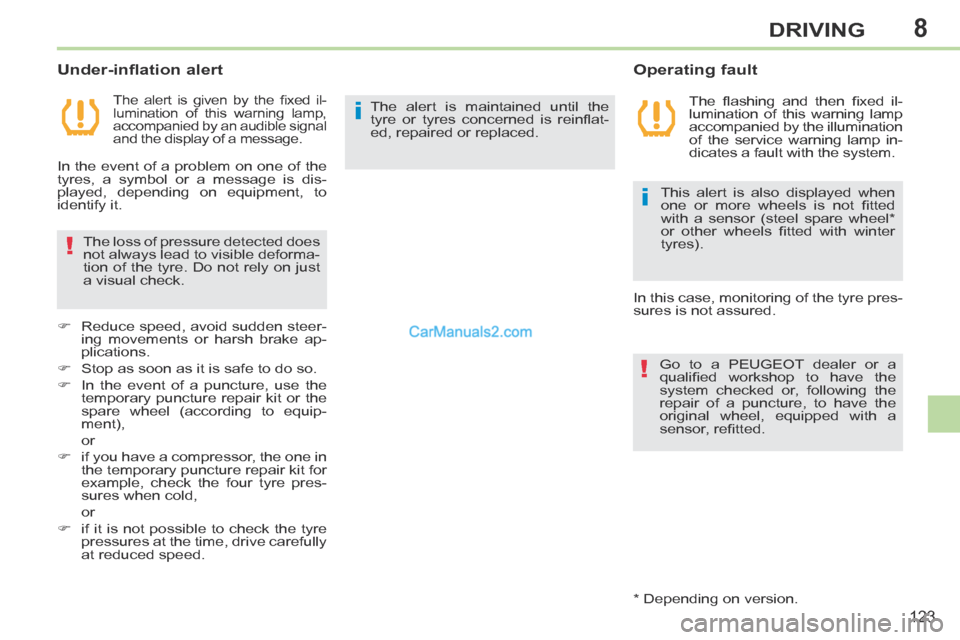
8
i
!
i
!
123
DRIVING
The alert is given by the fi xed il-
lumination of this warning lamp,
accompanied by an audible signal
and the display of a message.
Operating fault
Under-inflation alert
The loss of pressure detected does
not always lead to visible deforma-
tion of the tyre. Do not rely on just
a visual check. The alert is maintained until the
tyre or tyres concerned is reinfl at-
ed, repaired or replaced.
The fl ashing and then fi xed il-
lumination of this warning lamp
accompanied by the illumination
of the service warning lamp in-
dicates a fault with the system.
This alert is also displayed when
one or more wheels is not fi tted
with a sensor (steel spare wheel *
or other wheels fi tted with winter
tyres).
Go to a PEUGEOT dealer or a
qualifi ed workshop to have the
system checked or, following the
repair of a puncture, to have the
original wheel, equipped with a
sensor, refi tted.
In this case, monitoring of the tyre pres-
sures is not assured.
Reduce speed, avoid sudden steer- ing movements or harsh brake ap-
plications.
Stop as soon as it is safe to do so.
In the event of a puncture, use the temporary puncture repair kit or the
spare wheel (according to equip-
ment),
or
if you have a compressor, the one in the temporary puncture repair kit for
example, check the four tyre pres-
sures when cold,
or
if it is not possible to check the tyre pressures at the time, drive carefully
at reduced speed.
* Depending on version.
In the event of a problem on one of the
tyres, a symbol or a message is dis-
played, depending on equipment, to
identify it.
Page 126 of 268
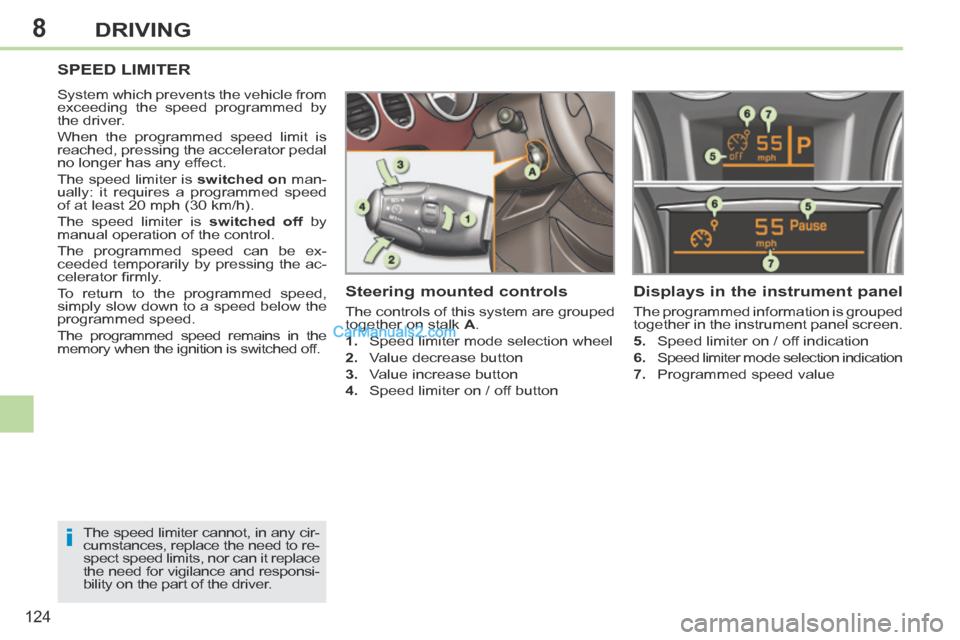
8
i
124
DRIVING
SPEED LIMITER
System which prevents the vehicle from
exceeding the speed programmed by
the driver.
When the programmed speed limit is
reached, pressing the accelerator pedal
no longer has any effect.
The speed limiter is switched on man-
ually: it requires a programmed speed
of at least 20 mph (30 km/h).
The speed limiter is switched off by
manual operation of the control.
The programmed speed can be ex-
ceeded temporarily by pressing the ac-
celerator fi rmly.
To return to the programmed speed,
simply slow down to a speed below the
programmed speed.
The programmed speed remains in the
memory when the ignition is switched off.
The speed limiter cannot, in any cir-
cumstances, replace the need to re-
spect speed limits, nor can it replace
the need for vigilance and responsi-
bility on the part of the driver.
Steering mounted controls
The controls of this system are grouped
together on stalk A .
1. Speed limiter mode selection wheel
2. Value decrease button
3. Value increase button
4. Speed limiter on / off button
Displays in the instrument panel
The programmed information is grouped
together in the instrument panel screen.
5. Speed limiter on / off indication
6. Speed limiter mode selection indication
7. Programmed speed value
Page 127 of 268
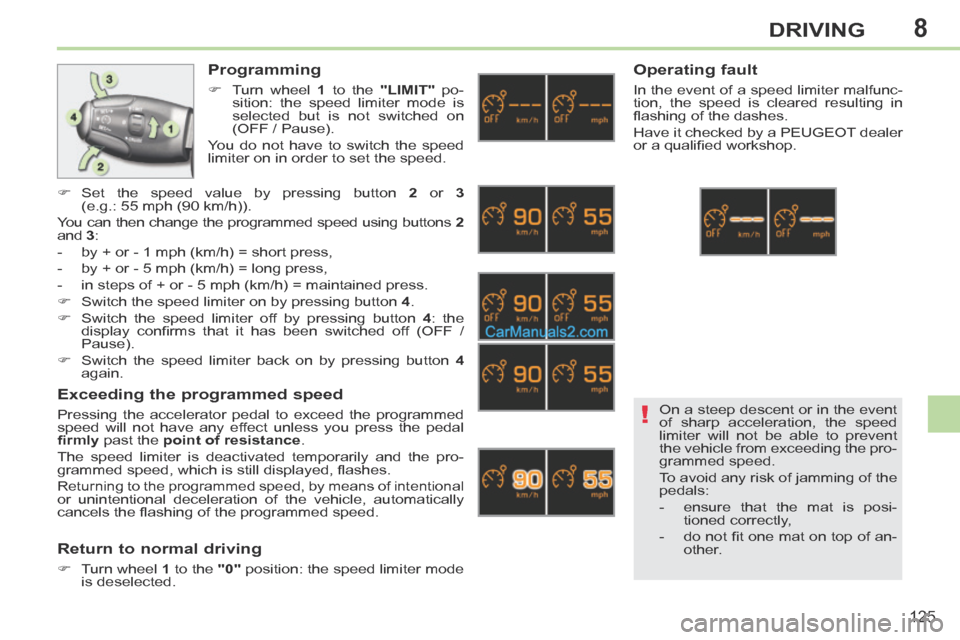
8
!
125
DRIVING
Programming
Turn wheel 1 to the "LIMIT" po-
sition: the speed limiter mode is
selected but is not switched on
(OFF / Pause).
You do not have to switch the speed
limiter on in order to set the speed.
Set the speed value by pressing button 2 or 3
(e.g.: 55 mph (90 km/h)).
You can then change the programmed speed using buttons 2
and 3 :
- by + or - 1 mph (km/h) = short press,
- by + or - 5 mph (km/h) = long press,
- in steps of + or - 5 mph (km/h) = maintained press.
Switch the speed limiter on by pressing button 4 .
Switch the speed limiter off by pressing button 4 : the
display confi rms that it has been switched off (OFF /
Pause).
Switch the speed limiter back on by pressing button 4
again.
Exceeding the programmed speed
Pressing the accelerator pedal to exceed the programmed
speed will not have any effect unless you press the pedal
fi rmly past the point of resistance .
The speed limiter is deactivated temporarily and the pro-
grammed speed, which is still displayed, fl ashes.
Returning to the programmed speed, by means of intentional
or unintentional deceleration of the vehicle, automatically
cancels the fl ashing of the programmed speed.
Return to normal driving
Turn wheel 1 to the "0" position: the speed limiter mode
is deselected.
Operating fault
In the event of a speed limiter malfunc-
tion, the speed is cleared resulting in
fl ashing of the dashes.
Have it checked by a PEUGEOT dealer
or a qualifi ed workshop.
On a steep descent or in the event
of sharp acceleration, the speed
limiter will not be able to prevent
the vehicle from exceeding the pro-
grammed speed.
To avoid any risk of jamming of the
pedals:
- ensure that the mat is posi-tioned correctly,
- do not fi t one mat on top of an- other.
Page 128 of 268
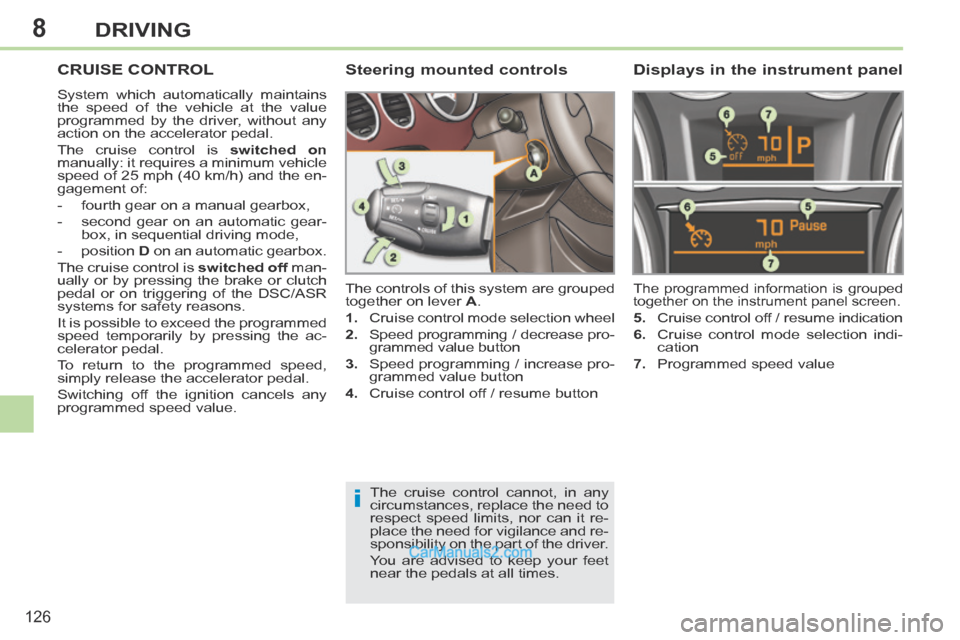
8
i
126
DRIVING
CRUISE CONTROL
System which automatically maintains
the speed of the vehicle at the value
programmed by the driver, without any
action on the accelerator pedal.
The cruise control is switched on
manually: it requires a minimum vehicle
speed of 25 mph (40 km/h) and the en-
gagement of:
- fourth gear on a manual gearbox,
- second gear on an automatic gear- box, in sequential driving mode,
- position D on an automatic gearbox.
The cruise control is switched off man-
ually or by pressing the brake or clutch
pedal or on triggering of the DSC/ASR
systems for safety reasons.
It is possible to exceed the programmed
speed temporarily by pressing the ac-
celerator pedal.
To return to the programmed speed,
simply release the accelerator pedal.
Switching off the ignition cancels any
programmed speed value. The controls of this system are grouped
together on lever
A .
1. Cruise control mode selection wheel
2. Speed programming / decrease pro- grammed value button
3. Speed programming / increase pro- grammed value button
4. Cruise control off / resume button
The programmed information is grouped
together on the instrument panel screen.
5. Cruise control off / resume indication
6. Cruise control mode selection indi- cation
7. Programmed speed value
Steering mounted controls Displays in the instrument panel
The cruise control cannot, in any
circumstances, replace the need to
respect speed limits, nor can it re-
place the need for vigilance and re-
sponsibility on the part of the driver.
You are advised to keep your feet
near the pedals at all times.
Page 129 of 268
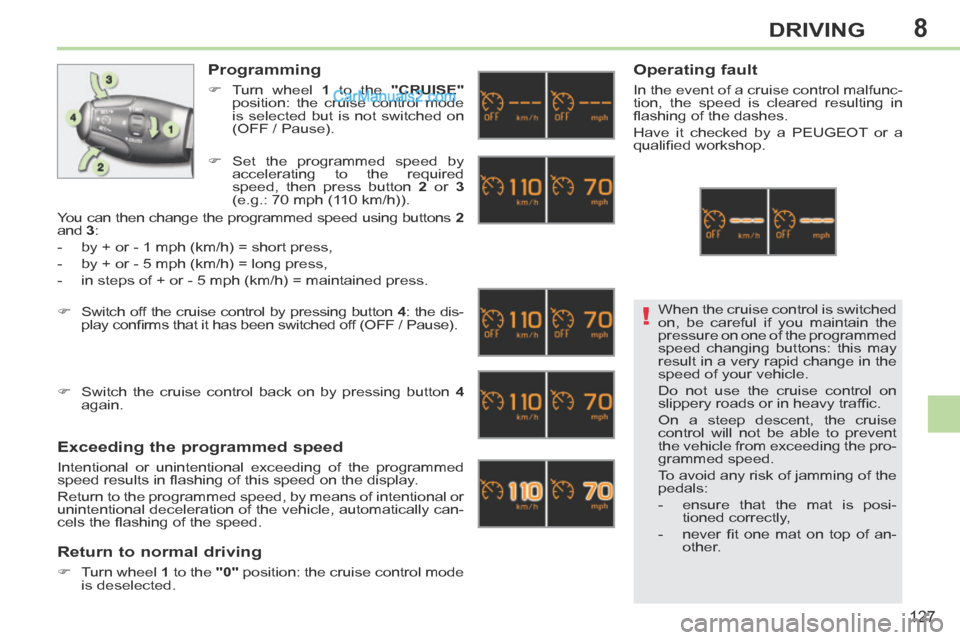
8
!
127
DRIVING
When the cruise control is switched
on, be careful if you maintain the
pressure on one of the programmed
speed changing buttons: this may
result in a very rapid change in the
speed of your vehicle.
Do not use the cruise control on
slippery roads or in heavy traffi c.
On a steep descent, the cruise
control will not be able to prevent
the vehicle from exceeding the pro-
grammed speed.
To avoid any risk of jamming of the
pedals:
- ensure that the mat is posi-tioned correctly,
- never fi t one mat on top of an- other.
Programming
Turn wheel 1 to the "CRUISE"
position: the cruise control mode
is selected but is not switched on
(OFF / Pause).
Exceeding the programmed speed
Intentional or unintentional exceeding of the programmed
speed results in fl ashing of this speed on the display.
Return to the programmed speed, by means of intentional or
unintentional deceleration of the vehicle, automatically can-
cels the fl ashing of the speed.
Return to normal driving
Turn wheel 1 to the "0" position: the cruise control mode
is deselected.
Operating fault
In the event of a cruise control malfunc-
tion, the speed is cleared resulting in
fl ashing of the dashes.
Have it checked by a PEUGEOT or a
qualifi ed workshop.
Set the programmed speed by accelerating to the required
speed, then press button 2 or 3
(e.g.: 70 mph (110 km/h)).
Switch off the cruise control by pressing button 4 : the dis-
play confi rms that it has been switched off (OFF / Pause).
Switch the cruise control back on by pressing button 4
again.
You can then change the programmed speed using buttons
2
and 3 :
- by + or - 1 mph (km/h) = short press,
- by + or - 5 mph (km/h) = long press,
- in steps of + or - 5 mph (km/h) = maintained press.
Page 142 of 268
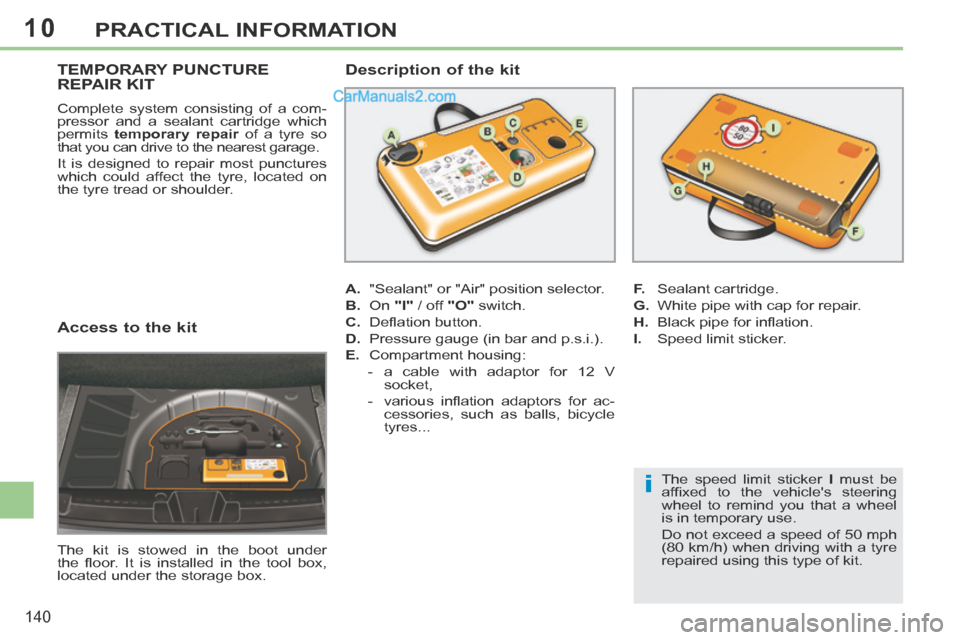
10
i
140
PRACTICAL INFORMATION
Access to the kit
The kit is stowed in the boot under
the fl oor. It is installed in the tool box,
located under the storage box.
TEMPORARY PUNCTURE REPAIR KIT
A. "Sealant" or "Air" position selector.
B. On "I" / off "O" switch.
C. Defl ation button.
D. Pressure gauge (in bar and p.s.i.).
E. Compartment housing: - a cable with adaptor for 12 V socket,
- various infl ation adaptors for ac- cessories, such as balls, bicycle
tyres...
Description of the kit
F. Sealant cartridge.
G. White pipe with cap for repair.
H. Black pipe for infl ation.
I. Speed limit sticker.
The speed limit sticker I must be
affi xed to the vehicle's steering
wheel to remind you that a wheel
is in temporary use.
Do not exceed a speed of 50 mph
(80 km/h) when driving with a tyre
repaired using this type of kit.
Complete system consisting of a com-
pressor and a sealant cartridge which
permits
temporary repair of a tyre so
that you can drive to the nearest garage.
It is designed to repair most punctures
which could affect the tyre, located on
the tyre tread or shoulder.
Page 144 of 268
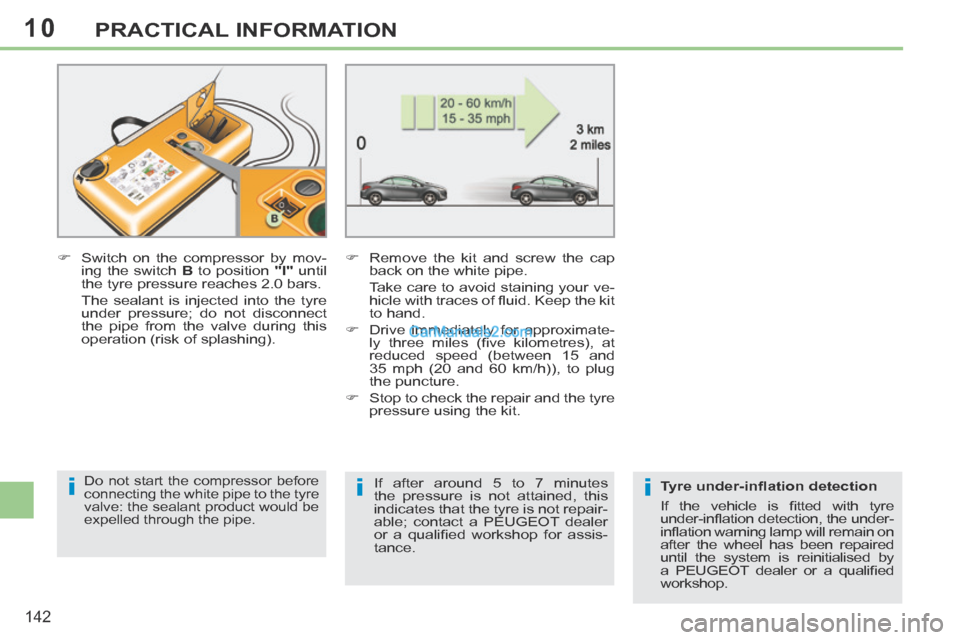
10
iii
142
PRACTICAL INFORMATION
Switch on the compressor by mov-ing the switch B to position "I" until
the tyre pressure reaches 2.0 bars.
The sealant is injected into the tyre under pressure; do not disconnect
the pipe from the valve during this
operation (risk of splashing). Remove the kit and screw the cap
back on the white pipe.
Take care to avoid staining your ve- hicle with traces of fl uid. Keep the kit
to hand.
Drive immediately for approximate- ly three miles (fi ve kilometres), at
reduced speed (between 15 and
35 mph (20 and 60 km/h)), to plug
the puncture.
Stop to check the repair and the tyre pressure using the kit.
Do not start the compressor before
connecting the white pipe to the tyre
valve: the sealant product would be
expelled through the pipe. Tyre under-infl ation detection
If the vehicle is fi tted with tyre
under-infl ation detection, the under-
infl ation warning lamp will remain on
after the wheel has been repaired
until the system is reinitialised by
a PEUGEOT dealer or a qualifi ed
workshop.
If after around 5 to 7 minutes
the pressure is not attained, this
i ndicates that the tyre is not repair-
able; contact a PEUGEOT dealer
or a qualifi ed workshop for assis-
tance.